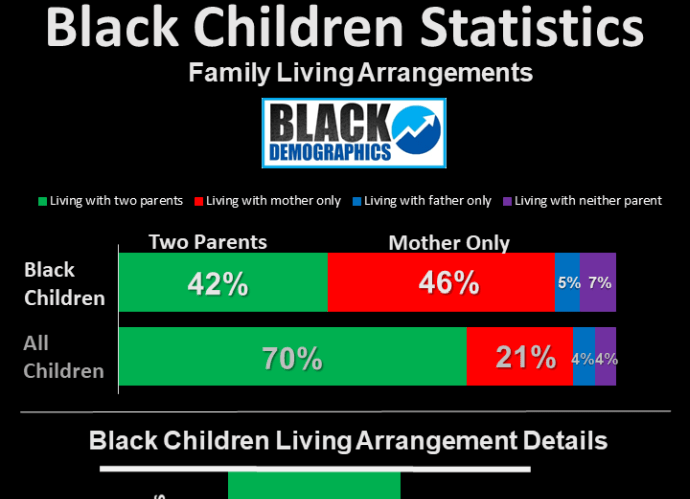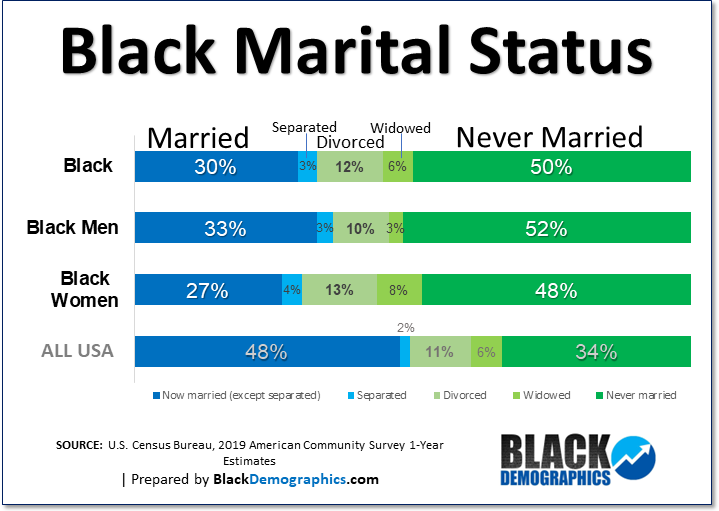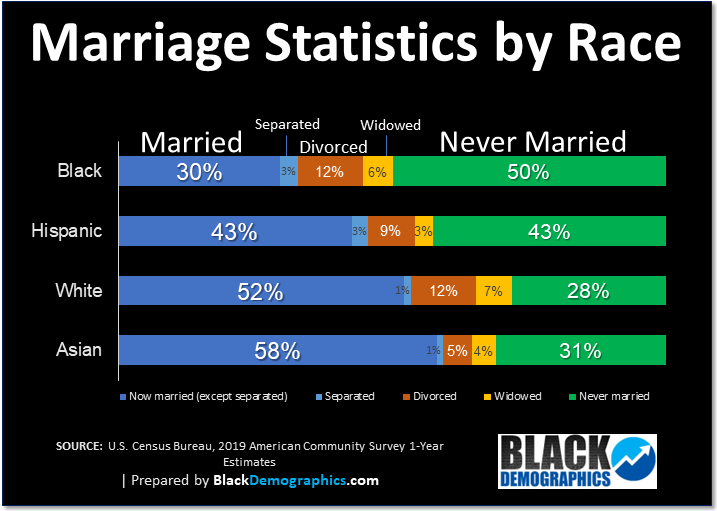[1] Data from U.S. Census reports reveal that between 1880-1960, married households consisting of two-parent homes were the most widespread form of African-American family structures. Although the most popular, married households decreased over this time period. Single-parent homes, on the other hand, remained relatively stable until 1960; when they rose dramatically. A study of 1880 family structures in Philadelphia, showed that three-quarters of Black families were nuclear families, composed of two parents and children. In New York City in 1925, 85% of kin-related Black households had two parents. In 1991, 68% of Black children were born outside of marriage. In 2011, 72% of Black babies were born to unmarried mothers. In 2015, 77% of Black babies were born to unmarried mothers. https://en.wikipedia.org/wiki/African-American_family_structure
[2] From 1980 thru 2008 93% of black victims were killed by blacks. (https://www.bjs.gov/content/pub/pdf/htus8008.pdf)
[3] By almost every measure African Americans socioeconomic conditions were better in 1970 than in 1940....Despite these economic and social advances black crime began to escalate markedly in the late 1960s and continued to play a major role in the multi-decade crime boom that followed. (https://www.hoplofobia.info/wp-content/uploads/2015/08/2018-African-American-Crime-Rates.pdf)
[4] homicide-victimization rates for black men were 3.9 times the national average and that 52 percent of all known homicide victims were black (2017 data)In 2018, where the homicide victim was black, the suspected killer also was 88 percent of the time. From 1976 to 2005, 94 percent of black victims were killed by other African Americans...From 2000 to 2015, the mean African-American homicide-victimization rate, adjusted for age, was 20.1 per 100,000. That’s more than three times the Hispanic rate of 6.4 (despite disadvantages comparable to those of blacks) and over seven times the average white rate, 2.7. Moreover, as already noted, from 1976 to 2005, 94 percent of the killers of black murder victims were other African Americans. (https://www.nationalreview.com/magazine/2019/12/22/the-need-to-discuss-black-on-black-crime/)
In 2012 The U.S Census Bureau released a report that studied the history of marriage in the United States. They discovered some startling statistics when calculating marriage by race. They found that African Americans age 35 and older were more likely to be married than White Americans from 1890 until sometime around the 1960s. Not only did they swap places during the 60s but in 1980 the number of NEVER married African Americans began a staggering climb from about 10% to more than 25% by 2010 while the percentage for White women remained under 10% and just over 10% for White men. The first two charts below are charts included in the report only the headings have been altered by BlackDemographics.com to outline these findings.


 -BlackDemographics.com © 2022 https://blackdemographics.com/households/marriage-in-black-america/
-BlackDemographics.com © 2022 https://blackdemographics.com/households/marriage-in-black-america/
The issue is that of culture, not color, of sin not skin.
"Growing up in Africa . . ., the culture of White racism and prejudice was not part of the African upbringing . . . . [w]e were aware of the history of slavery but, in all cases, we were wil ling to forget and forgive. It never occurred to us that we would be the targets of hate simply because of the color of our skin. Interestingly, ou r Black and brown skins did not open the doors wide for us in the African American community either. We were, and remain to many African Americans, outsiders or beneficiaries of their struggle against a racist society. If we are too successful and live in a nice White neighborhood, then we are accused of betraying our race, being "Black Bourgeois" and wanting to be White. To White neighbors, we are safe because we are Blacks from Africa . . ., not from the South or Brooklyn and, to their stereotypical way of thinking, we do not do drugs or alcohol or have big late night parties."
The higher rates of violence in American black culture is related to the decline of the traditional black family which liberal policies fostered.